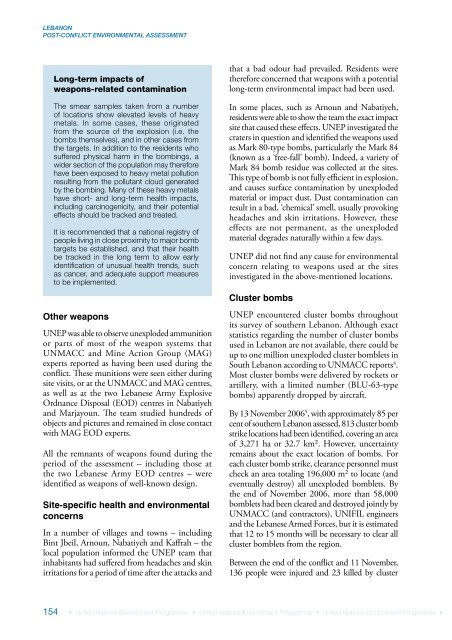Lebanon Post-Conflict Environmental Assessment - UNEP
Lebanon Post-Conflict Environmental Assessment - UNEP
Lebanon Post-Conflict Environmental Assessment - UNEP
Create successful ePaper yourself
Turn your PDF publications into a flip-book with our unique Google optimized e-Paper software.
LEBANONPOST-CONFLICT ENVIRONMENTAL ASSESSMENTLong-term impacts ofweapons-related contaminationThe smear samples taken from a numberof locations show elevated levels of heavymetals. In some cases, these originatedfrom the source of the explosion (i.e. thebombs themselves), and in other cases fromthe targets. In addition to the residents whosuffered physical harm in the bombings, awider section of the population may thereforehave been exposed to heavy metal pollutionresulting from the pollutant cloud generatedby the bombing. Many of these heavy metalshave short- and long-term health impacts,including carcinogenicity, and their potentialeffects should be tracked and treated.It is recommended that a national registry ofpeople living in close proximity to major bombtargets be established, and that their healthbe tracked in the long term to allow earlyidentification of unusual health trends, suchas cancer, and adequate support measuresto be implemented.Other weapons<strong>UNEP</strong> was able to observe unexploded ammunitionor parts of most of the weapon systems thatUNMACC and Mine Action Group (MAG)experts reported as having been used during theconflict. These munitions were seen either duringsite visits, or at the UNMACC and MAG centres,as well as at the two Lebanese Army ExplosiveOrdnance Disposal (EOD) centres in Nabatiyehand Marjayoun. The team studied hundreds ofobjects and pictures and remained in close contactwith MAG EOD experts.All the remnants of weapons found during theperiod of the assessment – including those atthe two Lebanese Army EOD centres – wereidentified as weapons of well-known design.Site-specific health and environmentalconcernsIn a number of villages and towns – includingBint Jbeil, Arnoun, Nabatiyeh and Kaffrah – thelocal population informed the <strong>UNEP</strong> team thatinhabitants had suffered from headaches and skinirritations for a period of time after the attacks andthat a bad odour had prevailed. Residents weretherefore concerned that weapons with a potentiallong-term environmental impact had been used.In some places, such as Arnoun and Nabatiyeh,residents were able to show the team the exact impactsite that caused these effects. <strong>UNEP</strong> investigated thecraters in question and identified the weapons usedas Mark 80-type bombs, particularly the Mark 84(known as a ‘free-fall’ bomb). Indeed, a variety ofMark 84 bomb residue was collected at the sites.This type of bomb is not fully efficient in explosion,and causes surface contamination by unexplodedmaterial or impact dust. Dust contamination canresult in a bad, ‘chemical’ smell, usually provokingheadaches and skin irritations. However, theseeffects are not permanent, as the unexplodedmaterial degrades naturally within a few days.<strong>UNEP</strong> did not find any cause for environmentalconcern relating to weapons used at the sitesinvestigated in the above-mentioned locations.Cluster bombs<strong>UNEP</strong> encountered cluster bombs throughoutits survey of southern <strong>Lebanon</strong>. Although exactstatistics regarding the number of cluster bombsused in <strong>Lebanon</strong> are not available, there could beup to one million unexploded cluster bomblets inSouth <strong>Lebanon</strong> according to UNMACC reports 4 .Most cluster bombs were delivered by rockets orartillery, with a limited number (BLU-63-typebombs) apparently dropped by aircraft.By 13 November 2006 5 , with approximately 85 percent of southern <strong>Lebanon</strong> assessed, 813 cluster bombstrike locations had been identified, covering an areaof 3,271 ha or 32.7 km². However, uncertaintyremains about the exact location of bombs. Foreach cluster bomb strike, clearance personnel mustcheck an area totaling 196,000 m² to locate (andeventually destroy) all unexploded bomblets. Bythe end of November 2006, more than 58,000bomblets had been cleared and destroyed jointly byUNMACC (and contractors), UNIFIL engineersand the Lebanese Armed Forces, but it is estimatedthat 12 to 15 months will be necessary to clear allcluster bomblets from the region.Between the end of the conflict and 11 November,136 people were injured and 23 killed by cluster154 • United Nations Environment Programme • United Nations Environment Programme • United Nations Environment Programme •
















